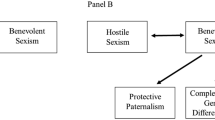Abstract
Alternate 25-item short forms of the Sex-Role Egalitarianism Scale (SRES) were developed and examined for psychometric quality using data from a sample of 608 students. Internal consistency coefficients were .94 and .92 for the two forms, stability coefficients with a three-week test-retest in terval were .88 for each, and the coefficient of equivalence or alternate forms reliability was .87. As expected, females scored significantly more egalitarian than males on both short forms, and results of factor analyses pointed to unidimensional measurement of a single construct for males, females, and the total sample. Additional support for reliability and validity is overviewed. The abbreviated SRES forms appear to provide a psychometrically sound and time-efficient means for assessing egalitarian attitudes.
Similar content being viewed by others
References
Beere, C. A., King, D. W., Beere, D. B., & King, L. A. (1984). The Sex-Role Egalitarianism Scale: A measure of attitudes toward equality between the sexes: Sex Roles, 10, 563–576.
Bem, S. L. (1974). The measurement of psychological androgyny. Journal of Consulting and Clinical Psychology, 42, 155–162.
Bem, S. L. (1978). The short Bem Sex-Role Inventory. Palo Alto, CA: Consulting Psychologists Press.
Bernstein, I. H., & Teng, G. (1989). Factoring items and factoring scales are different: Spurious evidence for multidimensionality due to item categorization. Psychological Bulletin, 105, 467–477.
Brabeck, M. M., & Weisgerber, K. (1989). College students' perceptions of men and women choosing teaching and management: The effects of gender and sex role egalitarianism. Sex Roles, 21, 841–857.
Byrne, B. B. (1988). Testing the factorial validity and invariance of a measuring instrument using LISREL confirmatory factor analysis: A reexamination and application. Multiple Linear Regression Viewpoints, 16, 33–80.
Crossman, R. K., Stith, S. M., & Bender, M. M. (in press). Sex role egalitarianism and marital violence. Sex Roles.
Edwards, A. L. (1957). The social desirability variable in personality assessment and research. New York: Dryden.
Etaugh, C. (1975). Biographical predictors of college students' attitudes toward women. Journal of College Student Personnel, 16, 273–275.
Goldberg, C. (1976). Women's Liberation Scale (WLS): A measure of attitude toward positions advocated by women's groups. JSAS Catalog of Selected Documents in Psychology, 6, 13 (Ms. No. 1187).
Grimes, M. D., & Hansen, G. L. (1984). Response bias in sex-role attitude measurement. Sex Roles, 10, 67–72.
Harman, H. H. (1967). Modern factor analysis (2nd ed., rev.). Chicago: University of Chicago Press.
Honeck, S. M. (1981). An exploratory study of the Beere-King Sex-Role Egalitarianism Scale, the MacDonald Sex Role Survey, and Spence and Helmreich's Attitudes Toward Women Scale. Unpublished master's thesis, Central Michigan University, Mt. Pleasant, MI.
Jackson, D. N. (1967). Personality Research Form manual. Goshen, NY: Research Psychologists Press.
Jean, P. J., & Reynolds, C. R. (1984). Sex and attitude distortion: Ability of females and males to fake liberal and conservative positions regarding changing sex roles. Sex Roles, 10, 805–815.
King, D. W., & King, L. A. (1983a). Measurement precision of the Sex-Role Egalitarianism Scale: A generalizability analysis. Educational psychological Measurement, 43, 435–447.
King, D. W., & King, L. A. (1983b). Sex-role egalitarianism as a moderator variable in decision-making: Two validity studies. Educational and Psychological Measurement, 43, 1199–1210.
King, L. A., Beere, D. B., King, D. W., & Beere, C. A. (1981). A new measure of sex-role attitudes. Paper presented at the annual meeting of the Midwestern Psychological Association, Detroit.
King, L. A., & King, D. W. (1985). Sex-role egalitarianism: Biographical and personality correlates. Psychological Reports, 57, 787!792.
King, L. A., & King, D. W. (1986). Validity of the Sex-Role Egalitarianism Scale: Discriminating egalitarianism from feminism. Sex Roles, 15, 207–214.
MacDonald, A. P., Jr. (1974). Identification and measurement of multidimensional attitudes toward equality between the sexes. Journal of Homosexuality, 1, 165–182.
Marsh, H. W., Barnes, J., Cairns, L., & Tidman, M. (1984). Self-Description Questionnaire: Age and sex effects in the structure and level of self-concept for preadolescent children. Journal of Educational Psychology, 76, 940–956.
McKinney, K. (1987). Age and gender differences in college students' attitudes toward women: A replication and extension. Sex Roles, 17, 353–358.
Razzano, L. A., Lombardo, J. P., & Francis, P. L. (1988). Sex Role egalitarianism and the devaluation of women's competence. Paper presented at the annual meeting of the Midwestern Psychological Association, Chicago.
Rosenfeld, L. B., & Jerrard, M. W. (1985). The effects of perceived sexism in female and male college professors on students' descriptions of classroom climate. Communication Education, 34, 205–213.
Rosenfeld, L. B., & Jerrard, M. W. (1986). Student coping mechanisms in sexist and nonsexist professors' classes. Communication Education, 35, 157–162.
Royse, D., & Clawson, D. (1988). Sex-role egalitarianism, feminism, and sexual identity. Psychological Reports, 63, 160–162.
Spence, J. T., & Helmreich, R. L. (1972). The Attitudes Toward Women Scale: An objective instrument to measure attitudes toward the rights and roles of women in contemporary society. JSAS Catalog of Selected Documents in Psychology, 2, 66 (Ms. No. 153).
Spence, J. T., Helmreich, R. L., & Stapp, J. (1973). A short version of the Attitudes Toward Women Scale (AWS). Bulletin of the Psychonomic Society, 2, 219–220.
Stith, S. M. (in press). Police response to domestic violence: The influence of individual and familial factors. Violence and Victims.
Stith, S. M., Crossman, R. K., & Bischof, G. P. (1990). Alcoholism and marital violence: A comparative study of men in alcohol treatment programs and batterer treatment programs. Manuscript under review.
Author information
Authors and Affiliations
Additional information
The authors wish to thank Tammi Stebleton, Marcel Macelli, and Rhonda Coates for their assistance with data management.
Rights and permissions
About this article
Cite this article
King, L.A., King, D.W. Abbreviated measures of sex role egalitarian attitudes. Sex Roles 23, 659–673 (1990). https://doi.org/10.1007/BF00289254
Issue Date:
DOI: https://doi.org/10.1007/BF00289254




